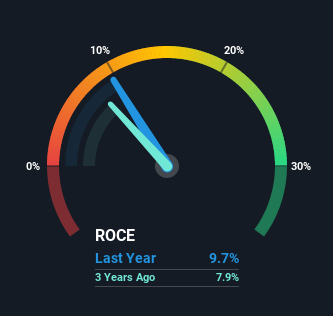
Finding a business that has the potential to grow substantially is not easy, but it is possible if we look at a few key financial metrics. Firstly, we'd want to identify a growing return on capital employed (ROCE) and then alongside that, an ever-increasing base of capital employed. Ultimately, this demonstrates that it's a business that is reinvesting profits at increasing rates of return. Speaking of which, we noticed some great changes in Byron Energy's (ASX:BYE) returns on capital, so let's have a look.
Return On Capital Employed (ROCE): What is it?
For those who don't know, ROCE is a measure of a company's yearly pre-tax profit (its return), relative to the capital employed in the business. Analysts use this formula to calculate it for Byron Energy:
Return on Capital Employed = Earnings Before Interest and Tax (EBIT) ÷ (Total Assets - Current Liabilities)
0.097 = US$9.2m ÷ (US$115m - US$19m) (Based on the trailing twelve months to June 2021).
Thus, Byron Energy has an ROCE of 9.7%. On its own that's a low return, but compared to the average of 2.9% generated by the Oil and Gas industry, it's much better.
View our latest analysis for Byron Energy

Historical performance is a great place to start when researching a stock so above you can see the gauge for Byron Energy's ROCE against it's prior returns. If you'd like to look at how Byron Energy has performed in the past in other metrics, you can view this free graph of past earnings, revenue and cash flow.
So How Is Byron Energy's ROCE Trending?
We're delighted to see that Byron Energy is reaping rewards from its investments and is now generating some pre-tax profits. The company was generating losses five years ago, but now it's earning 9.7% which is a sight for sore eyes. And unsurprisingly, like most companies trying to break into the black, Byron Energy is utilizing 1,710% more capital than it was five years ago. We like this trend, because it tells us the company has profitable reinvestment opportunities available to it, and if it continues going forward that can lead to a multi-bagger performance.
In Conclusion...
In summary, it's great to see that Byron Energy has managed to break into profitability and is continuing to reinvest in its business. Astute investors may have an opportunity here because the stock has declined 26% in the last five years. That being the case, research into the company's current valuation metrics and future prospects seems fitting.
If you want to know some of the risks facing Byron Energy we've found 3 warning signs (1 is a bit concerning!) that you should be aware of before investing here.
While Byron Energy isn't earning the highest return, check out this free list of companies that are earning high returns on equity with solid balance sheets.
Valuation is complex, but we're here to simplify it.
Discover if Byron Energy might be undervalued or overvalued with our detailed analysis, featuring fair value estimates, potential risks, dividends, insider trades, and its financial condition.
Access Free AnalysisHave feedback on this article? Concerned about the content? Get in touch with us directly. Alternatively, email editorial-team (at) simplywallst.com.
This article by Simply Wall St is general in nature. We provide commentary based on historical data and analyst forecasts only using an unbiased methodology and our articles are not intended to be financial advice. It does not constitute a recommendation to buy or sell any stock, and does not take account of your objectives, or your financial situation. We aim to bring you long-term focused analysis driven by fundamental data. Note that our analysis may not factor in the latest price-sensitive company announcements or qualitative material. Simply Wall St has no position in any stocks mentioned.
About ASX:BYE
Byron Energy
Engages in the exploration, development, and production of oil and gas properties.
Low and fair value.
Similar Companies
Market Insights
Community Narratives




